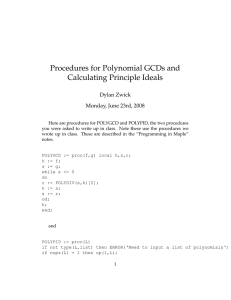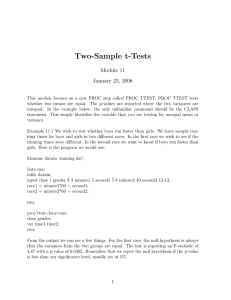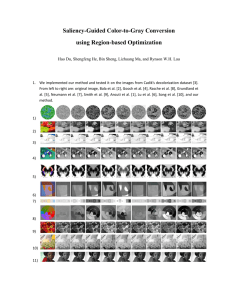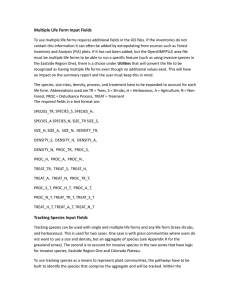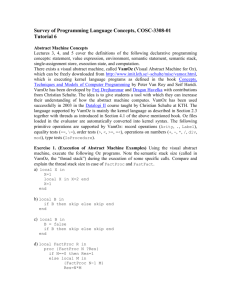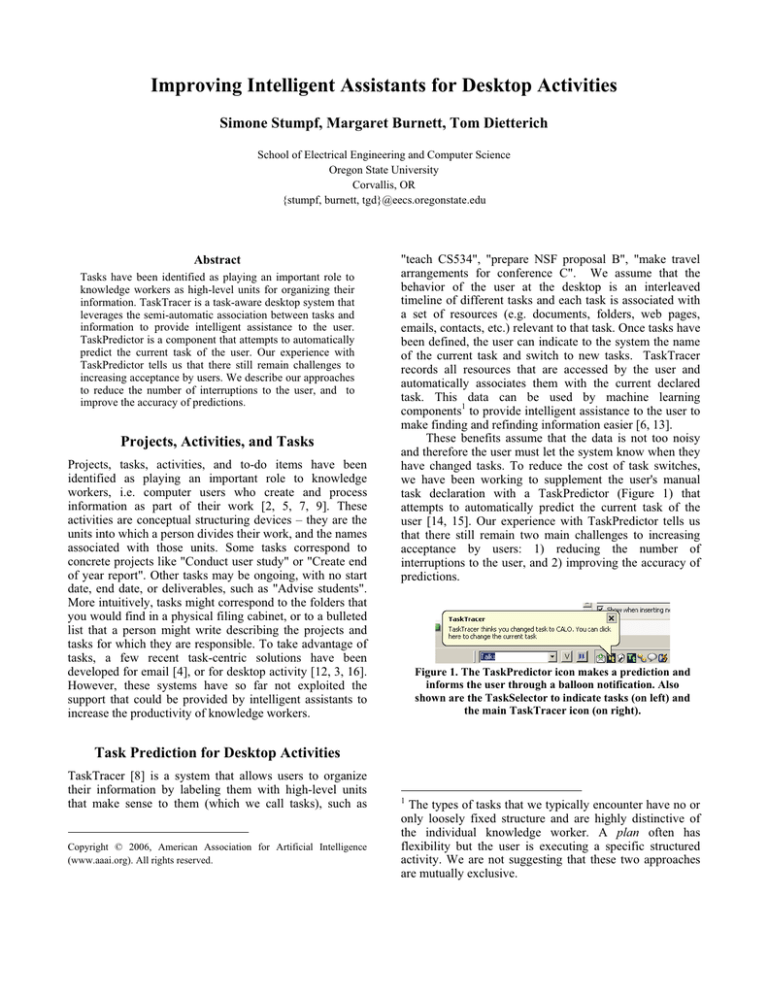
Improving Intelligent Assistants for Desktop Activities
Simone Stumpf, Margaret Burnett, Tom Dietterich
School of Electrical Engineering and Computer Science
Oregon State University
Corvallis, OR
{stumpf, burnett, tgd}@eecs.oregonstate.edu
Abstract
Tasks have been identified as playing an important role to
knowledge workers as high-level units for organizing their
information. TaskTracer is a task-aware desktop system that
leverages the semi-automatic association between tasks and
information to provide intelligent assistance to the user.
TaskPredictor is a component that attempts to automatically
predict the current task of the user. Our experience with
TaskPredictor tells us that there still remain challenges to
increasing acceptance by users. We describe our approaches
to reduce the number of interruptions to the user, and to
improve the accuracy of predictions.
Projects, Activities, and Tasks
Projects, tasks, activities, and to-do items have been
identified as playing an important role to knowledge
workers, i.e. computer users who create and process
information as part of their work [2, 5, 7, 9]. These
activities are conceptual structuring devices – they are the
units into which a person divides their work, and the names
associated with those units. Some tasks correspond to
concrete projects like "Conduct user study" or "Create end
of year report". Other tasks may be ongoing, with no start
date, end date, or deliverables, such as "Advise students".
More intuitively, tasks might correspond to the folders that
you would find in a physical filing cabinet, or to a bulleted
list that a person might write describing the projects and
tasks for which they are responsible. To take advantage of
tasks, a few recent task-centric solutions have been
developed for email [4], or for desktop activity [12, 3, 16].
However, these systems have so far not exploited the
support that could be provided by intelligent assistants to
increase the productivity of knowledge workers.
"teach CS534", "prepare NSF proposal B", "make travel
arrangements for conference C". We assume that the
behavior of the user at the desktop is an interleaved
timeline of different tasks and each task is associated with
a set of resources (e.g. documents, folders, web pages,
emails, contacts, etc.) relevant to that task. Once tasks have
been defined, the user can indicate to the system the name
of the current task and switch to new tasks. TaskTracer
records all resources that are accessed by the user and
automatically associates them with the current declared
task. This data can be used by machine learning
components1 to provide intelligent assistance to the user to
make finding and refinding information easier [6, 13].
These benefits assume that the data is not too noisy
and therefore the user must let the system know when they
have changed tasks. To reduce the cost of task switches,
we have been working to supplement the user's manual
task declaration with a TaskPredictor (Figure 1) that
attempts to automatically predict the current task of the
user [14, 15]. Our experience with TaskPredictor tells us
that there still remain two main challenges to increasing
acceptance by users: 1) reducing the number of
interruptions to the user, and 2) improving the accuracy of
predictions.
Figure 1. The TaskPredictor icon makes a prediction and
informs the user through a balloon notification. Also
shown are the TaskSelector to indicate tasks (on left) and
the main TaskTracer icon (on right).
Task Prediction for Desktop Activities
TaskTracer [8] is a system that allows users to organize
their information by labeling them with high-level units
that make sense to them (which we call tasks), such as
Copyright © 2006, American Association for Artificial Intelligence
(www.aaai.org). All rights reserved.
1
The types of tasks that we typically encounter have no or
only loosely fixed structure and are highly distinctive of
the individual knowledge worker. A plan often has
flexibility but the user is executing a specific structured
activity. We are not suggesting that these two approaches
are mutually exclusive.
Reducing the number of interruptions
In order to reduce the number of interruptions to the user, a
cost-sensitive approach to task prediction and notification
in the user interface is needed [10]. Currently, we already
reduce the number of possible notifications made by the
TaskPredictor through two main ways. First, we assume
that in an unbroken segment of time in which a particular
window has focus and the name of the document in that
window does not change, the user is still working on the
same task and hence we do not have to make a prediction.
Second, to keep user costs within reason for TaskPredictor,
we do not make a prediction for every window/document.
We are willing to accept lower coverage in order to
maintain high precision, because we would like to
minimize the number of interruptions, particularly if these
interruptions may provide wrong predictions. Thus, the
TaskPredictor employs a probabilistic threshold for
predicting tasks for windows/documents; if the threshold is
not reached then notification is not made. We are currently
exploring further options to better address user cost issues
by exploiting task boundaries [1, 11].
Improving the accuracy of predictions
One way of increasing the accuracy of predictions is by
incorporating user feedback. TaskPredictor at the moment
only allows the user to indicate that a prediction was wrong
and to specify what the correct prediction should have
been. This is just a glimpse of the rich knowledge users
have about the correct prediction, and we would like to
better harness the user’s knowledge to improve learning.
To investigate the feasibility of rich user feedback, we
conducted a formative think-aloud study with 13 email
users using 122 messages from the publicly available
Enron dataset (user farmer-d). In this study [17], machine
learning algorithms (Ripper and Naïve Bayes) sorted email
messages into folders and explained their reasoning using
three different simplified but faithful explanation
paradigms: Rule-based, Keyword-based, and Similaritybased. The participants were asked to provide feedback to
improve the pre-dictions. No restrictions were placed upon
the form or con-tent of participants’ feedback. We
observed and video-taped their activities and comments
throughout the experiment, as well as collecting their work
products, and questionnaires investigating their preferences
and behavior. From a user perspective, we assessed the
participants’ willingness to provide feedback, accuracy in
doing so, and ability to understand the different
explanations. From an algorithm perspective, we analyzed
the participants’ feedback to determine how easily its types
of advice could be understood and assimilated by machine
learning algorithms.
The system explains to the user
We provided simplified but faithful explanations of the
learning algorithms, which were concrete in terms of
KBKBKBKBEnglish common domain other
sense
11
11
4
13
Total
%
1. Adjust
39
12%
weight
2. Select
70
64
25
16
175 53%
different
features
(words)
3. Parse or
7
17
10
0
34
10%
extract in a
different way
4. Employ
9
5
2
1
17
5%
feature
combinations
5. Relational
0
9
5
0
14
4%
features
6. Other
3
12
4
33
52
16%
Total
100
118
50
63
331
%
30%
36%
15%
19%
Table 1: Types of participants’ changes (in rows) that
required various background knowledge (in columns).
specific features that were visible in the current email
message. Using these design principles, we found that
Rule-based explanations were the most understandable and
preferred but that a substantial number of the participants
chose one of the other explanation paradigms as their
favorite. This implies that machine learning systems may
need to support multiple explanation paradigms in order to
effectively reach all of their users.
The factors that contributed to participants' overall
preference of an explanation were approval of reasoning
soundness, clear communication of reasoning, perceived
accuracy, and a less technical style of expression.
Similarity-based
explanations
had
serious
understandability problems in our experiment.
The user gives rich feedback to the system
The participant corrections brought the accuracy rates for
all paradigms to almost identical levels (71-72%). When
the participants disagreed with the machine, participants
were usually right, but not always (introducing some noise
into the data).
Table 1 shows the results of our analysis in terms of
what type of feedback participants made and the
knowledge upon which it was based. Among the feedback
were requests for reweighting features, feature
combinations, relational features, and even wholesale
changes to the algorithms. Almost a third of the
participations’ suggestions relied on knowledge of English,
or on some knowledge that could be encoded once and
then reused. Roughly half of the suggestions for
improvement appear to be amenable to automated
assimilation with existing methods.
The results open new questions for research on methods
for assimilating complex user suggestions for feature
extraction, relational features, and incorporating
constraints on solutions found by learning algorithms.
They provide evidence that machine learning systems can
explain their reasoning and behavior to users, and that
users in turn can provide rich, informative feedback to the
learning system. This suggests rich user-machine
collaboration as a promising direction for intelligent user
interfaces to learn more effectively, by better harnessing of
the intelligence of users.
References
[1] Adamczyk, P. and B. Bailey. 2004. If Not Now, When? The
Effects of Interruption at Different Moments Within Task
Execution. Proc. CHI, Vienna, Austria.
[2] Bannon, L., Cypher, A., Greenspan, S., Monty, M. 1983.
Evaluation and analysis of users’ activity organization. Proc.
CHI, 54–57.
[3] Bardram, J., Bunde-Pedersen, J., Soegaard, M. 2006.
Support for activity-based computing in a personal
computing operating system. Proc. CHI, 211-220.
[4] Bellotti, V., Ducheneaut, N., Howard, M., Smith, I. 2003.
Taking email to task: The design and evaluation of a task
management centered email tool. Proc. CHI, 345–352.
[5] Bellotti, V., Dalal, B., Good, N., Flynn, P., Bobrow, D.,
Ducheneaut, N. 2004. What a to-do: Studies of task
management towards the design of a personal task list
manager. Proc. CHI, 735-742.
[6] Bao, X., Herlocker, J.L., Dietterich, T.G. 2006. Fewer Clicks
and Less Frustration: Reducing the Cost of Reaching the
Right Folder. Proc. IUI, Sydney, Australia, 2006.
[7] Czerwinski, M., Horvitz, E., Wilhite, S. 2004. A Diary Study
of Task Switching and Interruptions. Proc. CHI, 175-182.
[8] Dragunov, A., Dietterich, T. G., Johnsrude, K., McLaughin,
M., Li, L. and Herlocker, J. L. 2005. Tasktracer: A Desktop
Environment to Support Multi-Tasking Knowledge Workers.
Proc. IUI, San Diego, CA.
[9] Gonzalez, V., Mark, G. 2004. "Constant, constant, multitasking craziness": managing multiple working spheres.
Proc. CHI, 13–120.
[10] Horvitz, E., Kadie, C., Paek, T., Hovel, D. 2003. Models of
attention in computing and communication: from principles
to applications. Comms ACM 46(3), 52-59.
[11] Iqbal, S., P. Adamczyk, Zheng, X.S., Bailey, B. 2005.
Towards an Index of Opportunity: Understanding Changes
in Mental Workload During Task Execution. Proc. CHI,
Portland, OR.
[12] Kaptelinin, V. 2003. UMEA: Translating interaction
histories into project contexts. Proc. CHI, 353–360.
[13] Lettkeman, T., Stumpf, S., Irvine, J., Herlocker, J. 2006.
Predicting Task-Specific Webpages for Revisiting. Proc.
AAAI-06, Boston, MA.
[14] Shen, J., Li, L., Dietterich, T.G., Herlocker, J. L. 2006. A
hybrid learning system for recognizing user tasks from desk
activities and email messages. Proc. IUI, Sydney, Australia.
[15] Shen, J., Li, L., Dietterich, T.G. 2007. Real-Time Detection
of Task Switches of Desktop Users. Proc. IJCAI-07,
Hyderabad, India.
[16] Smith, G., Baudisch, P., Robertson, G. , Czerwinski, M. ,
Meyers, B. , Robbins, D. , Andrews, D. 2003. GroupBar:
The TaskBar Evolved. Proc. OZCHI , Brisbane,
Australia,34-43.
[17] Stumpf, S., Rajaram, V., Li, L., Burnett, M., Dietterich,
T.G., Sullivan, E. Drummond, R., Herlocker, J. 2007.
Toward Harnessing User Feedback For Machine Learning.
Proc. IUI'07, Honolulu, HI.

